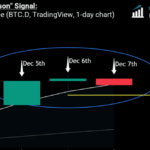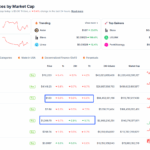The Ethereum market has once again found itself in the spotlight — but this time, the question isn’t whether ETH can rally, it’s whether its recent price swings are a sign of deeper instability or simply a healthy market reset. Over the past few weeks, Ethereum has experienced a roller-coaster pattern of gains and losses, …
Ethereum Price Swings: Volatility or Healthy Correction?

The Ethereum market has once again found itself in the spotlight — but this time, the question isn’t whether ETH can rally, it’s whether its recent price swings are a sign of deeper instability or simply a healthy market reset.
Over the past few weeks, Ethereum has experienced a roller-coaster pattern of gains and losses, leaving traders debating the driving forces behind these fluctuations. Is this just another chapter in crypto’s inherently volatile story, or are we witnessing the early stages of a sustainable correction that could strengthen ETH’s long-term position? Let’s break down the signals, the sentiment, and the bigger picture.
A Recap: Ethereum’s Recent Price Movements
Ethereum, the world’s second-largest cryptocurrency by market capitalization, saw a sharp climb earlier this quarter as bullish sentiment swept across the digital asset space. Fueled by optimism around Ethereum 2.0 staking rewards, growing DeFi activity, and potential ETF approvals, ETH broke through key resistance levels.
However, this rally was quickly followed by noticeable pullbacks. Daily percentage drops of 4–6% became common, and ETH’s price chart started showing wider swings — sometimes within just a few hours. While these movements might seem alarming, they’re not entirely unexpected in a market known for rapid sentiment shifts.
The Volatility Factor: Friend or Foe?
Volatility in cryptocurrency markets often gets a bad reputation. It’s seen as a sign of instability — and to traditional investors, such fluctuations might appear as excessive risk. But in the world of digital assets, volatility is not only common; it’s also a driver of opportunity.
For Ethereum, volatility can be traced to several key triggers:
- Market Liquidity – Crypto markets still have relatively lower liquidity compared to traditional assets. This means that large trades can cause outsized price movements.
- Leverage & Liquidations – Leveraged positions amplify both upward surges and downward crashes, as liquidations cascade through the order book.
- Sentiment-Driven Trading – Crypto investors are highly responsive to news, updates, and even rumors. Ethereum’s role as the backbone of DeFi and NFTs makes it particularly sensitive to such shifts.
In short: volatility is baked into the DNA of Ethereum’s market. The real question is whether this current bout of turbulence is destructive or constructive.
Signs of a Healthy Correction
A healthy correction occurs when a market that has overheated pulls back, consolidates, and builds a stronger base for future growth. In Ethereum’s case, there are several indicators suggesting that these swings might be part of a natural reset rather than a crash.
1. Profit-Taking After a Rally
Ethereum’s latest rally was substantial, and when assets hit multi-month highs, profit-taking is inevitable. Long-term holders cash in, short-term traders exit, and this creates temporary downward pressure.
2. Support Levels Holding Strong
Despite the dips, Ethereum has repeatedly bounced back from key technical support zones. The $X,XXX range (insert current support level) has acted as a floor multiple times, suggesting strong buying interest at those prices.
3. Network Fundamentals Remain Strong
Ethereum’s on-chain metrics — including daily active addresses, gas usage, and staking participation — have not shown major weakness. In fact, staking deposits continue to grow, signaling confidence in Ethereum’s future.
4. Healthy Trading Volume
Rather than drying up during the dip, trading volume has remained robust. This indicates that the market is still active and engaged, rather than retreating into panic mode.
The Bearish Perspective: Why Some Are Concerned
Of course, not all analysts are convinced that Ethereum’s current state is a simple correction. Some see warning signs:
- Macro-Economic Pressures – With global interest rates still high and inflationary concerns persisting, risk assets like crypto could face broader headwinds.
- Competition from Other Chains – Ethereum’s dominance is being challenged by faster, cheaper Layer-1 and Layer-2 solutions such as Solana, Avalanche, and Polygon.
- Regulatory Uncertainty – The looming possibility of stricter crypto regulations in the US and EU could impact sentiment.
From this perspective, Ethereum’s price swings could be seen as a sign of investor hesitation and reduced conviction.
Market Psychology: Why Sentiment Matters
In crypto, price often moves faster than fundamentals because sentiment plays such a huge role. The Ethereum market is no different.
When prices rise rapidly, optimism snowballs — social media hype grows, FOMO (fear of missing out) kicks in, and retail investors pile in. But when prices drop, the opposite happens: fear spreads quickly, short positions increase, and narratives turn bearish overnight.
Understanding this emotional cycle is key for investors. Ethereum’s price swings are not just technical events; they are also reflections of the collective psychology of traders worldwide.
What the Charts Are Saying
A closer look at ETH’s technical indicators reveals a mixed picture:
- Relative Strength Index (RSI) – Recently dipped from overbought levels, suggesting a cooling period that could prevent further overheating.
- Moving Averages – The 50-day moving average remains above the 200-day, keeping the long-term bullish trend intact for now.
- Fibonacci Retracement Levels – ETH’s pullback has stayed within the 38.2% retracement zone from its recent high, a common consolidation area in healthy corrections.
If Ethereum can hold above its critical support levels, these technical factors point toward stability rather than breakdown.
Long-Term Outlook: Building for the Future
For long-term Ethereum holders, short-term volatility is less concerning. The transition to Proof-of-Stake, upcoming scalability improvements via sharding, and continued dominance in the DeFi and NFT ecosystems give ETH a strong growth narrative.
Institutional adoption is also on the rise, with major financial players exploring Ethereum-based tokenization projects. If these trends continue, today’s price swings could simply be growing pains on the way to higher valuations.
Investor Takeaways
- Don’t Panic on Dips – Corrections are part of any healthy market cycle.
- Watch Support Zones Closely – A break below key levels could shift the outlook from “healthy correction” to “bearish trend.”
- Focus on Fundamentals – Ethereum’s network growth and developer activity remain strong.
- Diversify Exposure – Consider balancing ETH holdings with other Layer-1 and Layer-2 assets to manage risk.
Conclusion: Volatility Today, Stability Tomorrow?
Ethereum’s current price swings are both a reminder of crypto’s inherent volatility and a potential sign of market health. Corrections can shake out overleveraged positions, reset overbought conditions, and pave the way for more sustainable gains.
Whether these movements turn into a deeper downturn or a launchpad for the next rally will depend on a mix of technical, fundamental, and macroeconomic factors. For now, the evidence leans toward a healthy correction — but in the unpredictable world of crypto, the only constant is change.
As always in Ethereum’s story, volatility isn’t a bug — it’s part of the journey.







